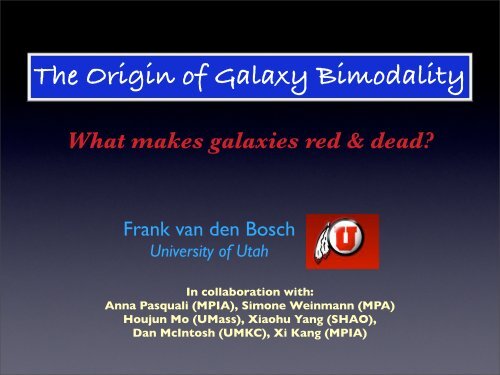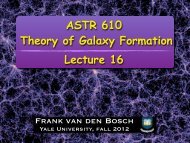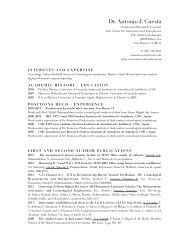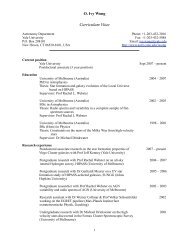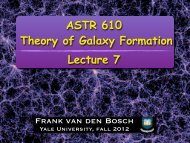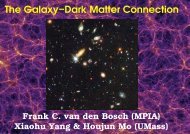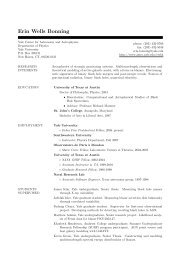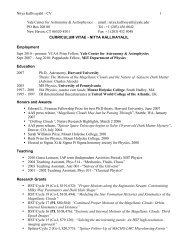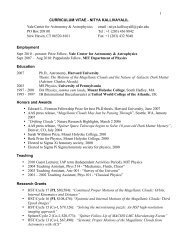The Origin of Galaxy Bimodality
The Origin of Galaxy Bimodality
The Origin of Galaxy Bimodality
Create successful ePaper yourself
Turn your PDF publications into a flip-book with our unique Google optimized e-Paper software.
<strong>The</strong> <strong>Origin</strong> <strong>of</strong> <strong>Galaxy</strong> <strong>Bimodality</strong><br />
What makes galaxies red & dead?<br />
Frank van den Bosch<br />
University <strong>of</strong> Utah<br />
In collaboration with:<br />
Anna Pasquali (MPIA), Simone Weinmann (MPA)<br />
Houjun Mo (UMass), Xiaohu Yang (SHAO),<br />
Dan McIntosh (UMKC), Xi Kang (MPIA)
<strong>The</strong> Bi-Modal Distribution <strong>of</strong> Galaxies<br />
Early-Type<br />
Spheroidal Morphology<br />
Old Stellar Populations<br />
No or Little Cold Gas<br />
Red Colors<br />
Late-Type<br />
Disk-Like Morphology<br />
Young Stellar Populations<br />
Abundant Cold Gas<br />
Blue colors<br />
Frank van den Bosch University <strong>of</strong> Utah
<strong>The</strong> Bi-Modal Distribution <strong>of</strong> Galaxies<br />
Early-Type<br />
Spheroidal Morphology<br />
Old Stellar Populations<br />
No or Little Cold Gas<br />
Red Colors<br />
Late-Type<br />
What is the origin <strong>of</strong> this bimodality?<br />
Disk-Like Morphology<br />
Young Stellar Populations<br />
Abundant Cold Gas<br />
Blue colors<br />
Frank van den Bosch University <strong>of</strong> Utah
PARADIGM:<br />
red<br />
blue<br />
<strong>The</strong> Standard Paradigm<br />
All Galaxies <strong>Origin</strong>ally form as Central Disk Galaxies<br />
Wolf et al. 2003; Bell et al. 2004; Borch et al. 2006<br />
Frank van den Bosch University <strong>of</strong> Utah
central<br />
<strong>Galaxy</strong> Transformations<br />
orbit<br />
orbit<br />
central<br />
accretion<br />
merging<br />
quenching<br />
In LCDM cosmology dark matter haloes grow hierarchically<br />
A major merger between disk galaxies results in an early-type remnant<br />
sub!<br />
halo<br />
central<br />
satellite satellite<br />
<strong>The</strong>re are also several satellite-specific transformation processes<br />
Strangulation<br />
Ram-pressure stripping<br />
<strong>Galaxy</strong> harassment<br />
(stripping <strong>of</strong> hot gas atmosphere)<br />
(stripping <strong>of</strong> cold gas)<br />
(impulsive encounters with other satellites)<br />
Frank van den Bosch University <strong>of</strong> Utah
Outstanding Questions<br />
What fraction <strong>of</strong> the red-sequence satellites underwent their<br />
transformation as a satellite?<br />
Which transformation process is most important?<br />
In what environment (dark matter halo) do galaxies undergo<br />
their transformation?<br />
To what extent are satellite-specific transformation processes<br />
responsible for environment dependence <strong>of</strong> galaxy population?<br />
Frank van den Bosch University <strong>of</strong> Utah
Outstanding Questions<br />
What fraction <strong>of</strong> the red-sequence satellites underwent their<br />
transformation as a satellite?<br />
Which transformation process is most important?<br />
In what environment (dark matter halo) do galaxies undergo<br />
their transformation?<br />
To what extent are satellite-specific transformation processes<br />
responsible for environment dependence <strong>of</strong> galaxy population?<br />
To address these questions, we constructed a large galaxy group<br />
catalogue from the SDSS<br />
Yang et al. 2005, 2007<br />
This allows us to split galaxy population in centrals and satellites,<br />
and to study galaxy properties as function <strong>of</strong> halo mass<br />
In particular, we study impact <strong>of</strong> satellite specific transformation<br />
processes by comparing satellites to centrals <strong>of</strong> the same stellar mass.<br />
Frank van den Bosch University <strong>of</strong> Utah
Centrals vs. Satellites<br />
Sats are marginally redder than centrals <strong>of</strong> same stellar mass<br />
van den Bosch et al. (2008)<br />
Frank van den Bosch University <strong>of</strong> Utah
Blue-to-Red Transition Fractions<br />
<strong>The</strong> red fraction <strong>of</strong> sats is higher than that <strong>of</strong> centrals <strong>of</strong> same M_star<br />
Roughly 40% <strong>of</strong> sats that are blue at accretion undergo transition<br />
10 -2<br />
f_tr|s,bc<br />
f_tr|s<br />
f_tr|rs<br />
Above 10 h Msun majority <strong>of</strong> sats were already red at accretion<br />
Satellite transformation processes are only important at low M_star<br />
van den Bosch et al. (2008)<br />
Frank van den Bosch University <strong>of</strong> Utah
Dependence on Halo Mass<br />
Color Difference is independent <strong>of</strong> halo mass <strong>of</strong> satellite<br />
Transformation efficiency is independent <strong>of</strong> halo mass <strong>of</strong> satellite<br />
Strangulation is main satellite-specific transformation process<br />
van den Bosch et al. (2008)<br />
Frank van den Bosch University <strong>of</strong> Utah
Satellite Ecology<br />
Satellites Only!!!<br />
At fixed stellar mass the average satellite color<br />
is independent <strong>of</strong> halo mass<br />
van den Bosch et al. (2009)<br />
Frank van den Bosch University <strong>of</strong> Utah
<strong>The</strong> Dearth <strong>of</strong> Environment Dependence<br />
colors<br />
Satellite color distribution depends strongly on stellar mass,<br />
but only very weakly on halo mass (environment)<br />
van den Bosch et al. (2009)<br />
Frank van den Bosch University <strong>of</strong> Utah
<strong>The</strong> Dearth <strong>of</strong> Environment Dependence<br />
concentrations<br />
Satellite concentration distribution depends strongly on stellar mass,<br />
but is virtually independent <strong>of</strong> halo mass (environment)<br />
van den Bosch et al. (2009)<br />
Frank van den Bosch University <strong>of</strong> Utah
Density distributions <strong>of</strong> centrals and satellites<br />
low concentration systems:<br />
Centrals are brighter and bluer,<br />
especially at larger radii.<br />
high concentration systems:<br />
Surface photometry <strong>of</strong> centrals<br />
and satellites indistinguishable.<br />
Independent <strong>of</strong> concentration,<br />
centrals and satellites have the<br />
same average stellar surface<br />
density, consistent with satellites<br />
being quenched centrals.<br />
Weinmann et al. 2009<br />
Frank van den Bosch University <strong>of</strong> Utah
Modeling Strangulation<br />
In standard SAMs, hot halo is instantaneously removed;<br />
results in red satellite fraction that is too large...<br />
Kang & van den Bosch (2008)<br />
see also Weinmann et al. (2006) and Baldy et al. (2006)<br />
Frank van den Bosch University <strong>of</strong> Utah
Modeling Strangulation<br />
Mhot(t) =Mhot(tacc)e −(t−tacc)/τ<br />
Delaying hot gas removal reduces red satellite fraction,<br />
but increases blue fraction <strong>of</strong> massive centrals.....<br />
Frank van den Bosch University <strong>of</strong> Utah
Modeling Strangulation<br />
Half <strong>of</strong> orphans with M∗ < 10 10 h −1 M⊙tidally disrupted<br />
If significant fraction <strong>of</strong> low mass satellites is tidally disrupted<br />
before being accreted by central, data can be fit satisfactory<br />
Frank van den Bosch University <strong>of</strong> Utah
<strong>The</strong> Fate <strong>of</strong> Satellite Galaxies<br />
Use unevolved subhalo mass function to predict CLF <strong>of</strong> satellites,<br />
under the assumption that CLF <strong>of</strong> centrals does not evolve with redshift<br />
Yang, Mo & vdB (2009)<br />
Symbols: group catalogue<br />
Lines: model predictions<br />
Frank van den Bosch University <strong>of</strong> Utah
<strong>The</strong> Fate <strong>of</strong> Satellite Galaxies<br />
Use unevolved subhalo mass function to predict CLF <strong>of</strong> satellites,<br />
under the assumption that CLF <strong>of</strong> centrals does not evolve with redshift<br />
Yang, Mo & vdB (2009)<br />
Symbols: group catalogue<br />
Lines: model predictions<br />
Model overpredicts number <strong>of</strong> satellites, especially in low mass haloes.<br />
Satellites have to be (tidally) destroyed, or be accreted by centrals.<br />
Frank van den Bosch University <strong>of</strong> Utah
<strong>The</strong> Fate <strong>of</strong> Satellite Galaxies<br />
We fit CLF <strong>of</strong> satellites assuming a survival fraction that only depends<br />
on ratio <strong>of</strong> subhalo mass (at time <strong>of</strong> accretion) and halo mass.<br />
Yang, Mo & vdB (2009)<br />
Frank van den Bosch University <strong>of</strong> Utah
<strong>The</strong> Fate <strong>of</strong> Satellite Galaxies<br />
We fit CLF <strong>of</strong> satellites assuming a survival fraction that only depends<br />
on ratio <strong>of</strong> subhalo mass (at time <strong>of</strong> accretion) and halo mass.<br />
Yang, Mo & vdB (2009)<br />
More massive subhaloes (and their satellites) are less likely to survive.<br />
Consistent with dynamical friction efficiency increasing with subhalo mass.<br />
Frank van den Bosch University <strong>of</strong> Utah
<strong>The</strong> Fate <strong>of</strong> Disrupted Satellite Galaxies<br />
un-evolved<br />
surviving satellites<br />
non-survivors<br />
centrals<br />
In massive haloes, the stellar mass in non-surviving satellites is<br />
several times larger than stellar mass <strong>of</strong> central galaxy.<br />
Consequently, most <strong>of</strong> the non-surviving satellites have to be disrupted,<br />
giving rise to a significant stellar halo.<br />
Frank van den Bosch University <strong>of</strong> Utah
<strong>The</strong> Fate <strong>of</strong> Disrupted Satellite Galaxies<br />
un-evolved<br />
surviving satellites<br />
non-survivors<br />
centrals<br />
Satellite disruption is important ingredient for galaxy formation.<br />
(see also Monaco et al. 2006 & Conroy et al. 2007)<br />
In massive haloes, the stellar mass in non-surviving satellites is<br />
several times larger than stellar mass <strong>of</strong> central galaxy.<br />
Consequently, most <strong>of</strong> the non-surviving satellites have to be disrupted,<br />
giving rise to a significant stellar halo.<br />
Frank van den Bosch University <strong>of</strong> Utah
<strong>The</strong> Amount <strong>of</strong> Intra-Cluster Light<br />
data taken from<br />
Gonzales et al. (2007)<br />
Predicted amount <strong>of</strong> ICL consistent with observations<br />
Yang, Mo & vdB (2009)<br />
Frank van den Bosch University <strong>of</strong> Utah
Conclusions<br />
What fraction <strong>of</strong> the red-sequence satellites underwent their<br />
transformation as a satellite?<br />
Which transformation process is most important?<br />
In what environment (dark matter halo) do galaxies undergo<br />
their transformation?<br />
To what extent are satellite-specific transformation processes<br />
responsible for environment dependence <strong>of</strong> galaxy population?<br />
Frank van den Bosch University <strong>of</strong> Utah
Conclusions<br />
What fraction <strong>of</strong> the red-sequence satellites underwent their<br />
transformation as a satellite?<br />
9<br />
From 70% for satellites with M_star = 10 Msun,<br />
to 0% for the most massive satellites<br />
Which transformation process is most important?<br />
In what environment (dark matter halo) do galaxies undergo<br />
their transformation?<br />
To what extent are satellite-specific transformation processes<br />
responsible for environment dependence <strong>of</strong> galaxy population?<br />
Frank van den Bosch University <strong>of</strong> Utah
Conclusions<br />
What fraction <strong>of</strong> the red-sequence satellites underwent their<br />
transformation as a satellite?<br />
9<br />
From 70% for satellites with M_star = 10 Msun,<br />
to 0% for the most massive satellites<br />
Which transformation process is most important?<br />
Strangulation...but needs to be better understood.<br />
Also, tidal disruption seems to be important...<br />
In what environment (dark matter halo) do galaxies undergo<br />
their transformation?<br />
To what extent are satellite-specific transformation processes<br />
responsible for environment dependence <strong>of</strong> galaxy population?<br />
Frank van den Bosch University <strong>of</strong> Utah
Conclusions<br />
What fraction <strong>of</strong> the red-sequence satellites underwent their<br />
transformation as a satellite?<br />
9<br />
From 70% for satellites with M_star = 10 Msun,<br />
to 0% for the most massive satellites<br />
Which transformation process is most important?<br />
Strangulation...but needs to be better understood.<br />
Also, tidal disruption seems to be important...<br />
In what environment (dark matter halo) do galaxies undergo<br />
their transformation?<br />
In all halos <strong>of</strong> all masses...<br />
To what extent are satellite-specific transformation processes<br />
responsible for environment dependence <strong>of</strong> galaxy population?<br />
Frank van den Bosch University <strong>of</strong> Utah
Conclusions<br />
What fraction <strong>of</strong> the red-sequence satellites underwent their<br />
transformation as a satellite?<br />
9<br />
From 70% for satellites with M_star = 10 Msun,<br />
to 0% for the most massive satellites<br />
Which transformation process is most important?<br />
Strangulation...but needs to be better understood.<br />
Also, tidal disruption seems to be important...<br />
In what environment (dark matter halo) do galaxies undergo<br />
their transformation?<br />
In all halos <strong>of</strong> all masses...<br />
To what extent are satellite-specific transformation processes<br />
responsible for environment dependence <strong>of</strong> galaxy population?<br />
<strong>The</strong>re is no environment dependence....<br />
Frank van den Bosch University <strong>of</strong> Utah
Frank’s hot advice:
Frank’s hot advice:<br />
Stop fiddling around with environment dependence;<br />
try to understand the stellar mass dependence<br />
<strong>of</strong> galaxy properties instead


